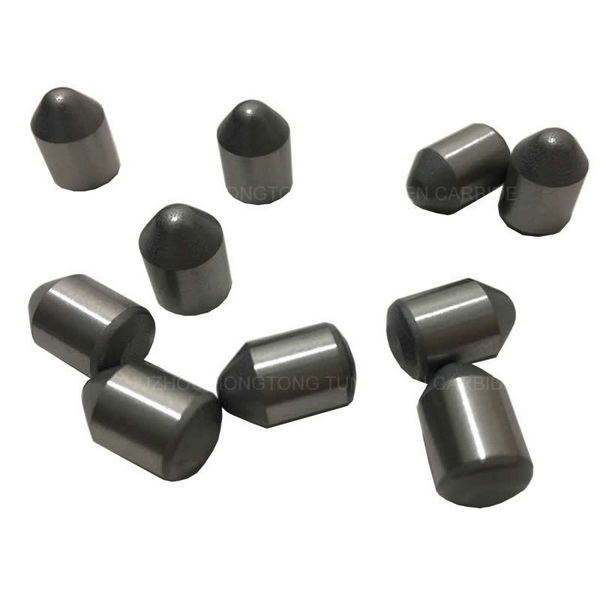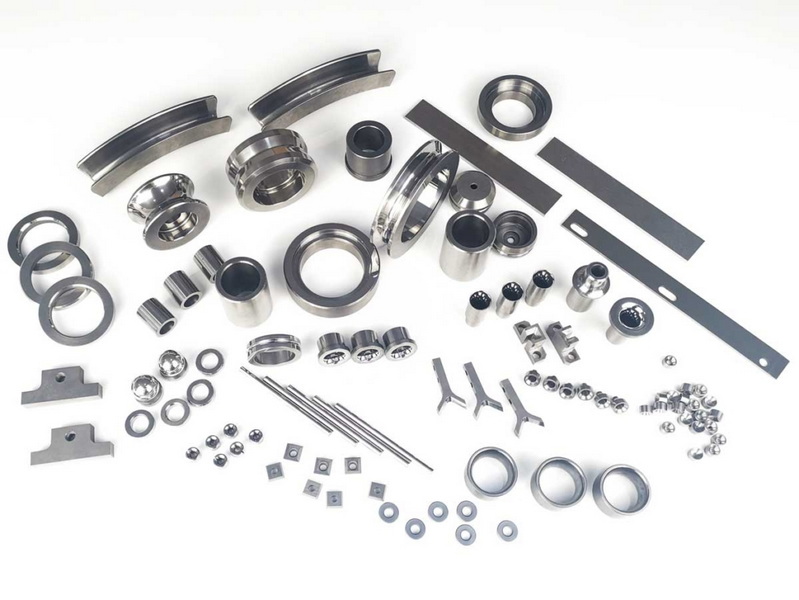Content Menu
● The Composition of Tungsten Carbide
● Exceptional Hardness
● Wear Resistance
● Compressive Strength
● Thermal Properties
● Chemical Resistance
● Applications Showcasing Tungsten Carbide's Durability
>> Cutting Tools
>> Mining and Drilling
>> Aerospace and Aviation
>> Jewelry
● Limitations of Tungsten Carbide's Durability
● Comparing Tungsten Carbide to Other Materials
● Future Developments in Tungsten Carbide Durability
● Conclusion
● FAQ
>> 1. How does the hardness of tungsten carbide compare to diamond?
>> 2. Can tungsten carbide rings be resized?
>> 3. Is tungsten carbide resistant to scratches?
>> 4. How does the weight of tungsten carbide compare to other metals?
>> 5. Can tungsten carbide withstand high temperatures?
● Citations:
Tungsten carbide is renowned for its exceptional durability, making it one of the most sought-after materials in various industries. This article delves into the remarkable properties of tungsten carbide, exploring its composition, characteristics, and applications that showcase its impressive durability.

The Composition of Tungsten Carbide
Tungsten carbide is a composite material formed by combining tungsten and carbon atoms in a precise ratio. Typically, it consists of approximately 94% tungsten and 6% carbon by weight[1]. This composition results in a dense, hexagonal crystal structure that contributes to its extraordinary hardness and durability.
The manufacturing process of tungsten carbide involves sintering tungsten carbide powder with a metallic binder, usually cobalt or nickel. This binder enhances the material's toughness and resilience, creating a cermet (ceramic-metallic composite) that combines the high hardness of ceramic tungsten carbide with the ductility of metallic binders[1].
Exceptional Hardness
One of the most notable features of tungsten carbide's durability is its exceptional hardness. On the Mohs scale of mineral hardness, tungsten carbide ranks between 9 and 9.5, second only to diamond, which has a hardness of 10[2][5]. This extraordinary hardness translates to superior wear resistance, making tungsten carbide an ideal material for applications that require long-lasting, durable components.
The hardness of tungsten carbide is not just a surface-level property. It extends throughout the material, ensuring consistent performance even as the surface wears over time. This characteristic makes tungsten carbide particularly valuable in cutting tools, drill bits, and other applications where maintaining a sharp edge is crucial.
Wear Resistance
The exceptional hardness of tungsten carbide directly contributes to its outstanding wear resistance. In fact, tungsten carbide can wear up to 100 times longer than steel under similar conditions[9]. This remarkable wear resistance is due to the material's ability to maintain its structural integrity even under extreme abrasive, erosive, and high-impact conditions.
In industrial applications, the wear resistance of tungsten carbide translates to:
1. Extended tool life
2. Reduced downtime for equipment maintenance
3. Improved productivity
4. Lower overall operational costs
These benefits make tungsten carbide an economical choice despite its higher initial cost compared to other materials.
Compressive Strength
Another aspect of tungsten carbide's durability is its impressive compressive strength. Tungsten carbide can withstand pressures up to 7,000 MPa, a value surpassed only by diamond[21]. This exceptional compressive strength allows tungsten carbide components to maintain their shape and functionality under extreme pressure conditions.
The high compressive strength of tungsten carbide makes it ideal for applications such as:
- Mining equipment
- Metal forming dies
- High-pressure pumps
- Armor-piercing ammunition
In these applications, the ability of tungsten carbide to withstand intense pressure without deforming or breaking is crucial for both performance and safety.
Thermal Properties
The durability of tungsten carbide extends to its thermal properties as well. With a melting point of approximately 2,870°C (5,200°F), tungsten carbide maintains its structural integrity and performance at elevated temperatures[5]. This high melting point, combined with good thermal conductivity, makes tungsten carbide an excellent choice for high-temperature applications.
Some key thermal properties of tungsten carbide include:
- High thermal stability
- Low coefficient of thermal expansion
- Excellent resistance to thermal shock
These properties contribute to the material's durability by allowing it to maintain its performance characteristics even in environments with rapid temperature changes or sustained high temperatures.

Chemical Resistance
Tungsten carbide's durability is further enhanced by its excellent chemical resistance. It is highly resistant to most acids, bases, and corrosive environments[1]. This chemical stability ensures that tungsten carbide components maintain their integrity and performance even when exposed to harsh chemical conditions.
The chemical resistance of tungsten carbide makes it particularly valuable in:
- Chemical processing equipment
- Oil and gas industry components
- Marine applications
- Aerospace components
In these environments, the ability of tungsten carbide to resist chemical attack contributes significantly to its overall durability and longevity.
Applications Showcasing Tungsten Carbide's Durability
The exceptional durability of tungsten carbide is evident in its wide range of applications across various industries. Let's explore some key areas where tungsten carbide's durability plays a crucial role:
Cutting Tools
In the manufacturing industry, tungsten carbide cutting tools are prized for their ability to maintain sharp edges and resist wear even under high-speed, high-temperature cutting conditions[18]. These tools can operate at higher cutting speeds and feed rates compared to traditional high-speed steel tools, resulting in increased productivity and better surface finishes.
Mining and Drilling
The mining and oil & gas industries rely heavily on tungsten carbide components for their durability in extreme conditions. Drill bits, mining picks, and other wear parts made from tungsten carbide can withstand the abrasive and high-impact environments encountered in these applications[26].
Aerospace and Aviation
In the aerospace industry, tungsten carbide is used in various components that require high wear resistance and thermal stability. These include turbine blade coatings, landing gear components, and other critical parts that must withstand extreme conditions[18].
Jewelry
The durability of tungsten carbide has made it increasingly popular in the jewelry industry, particularly for wedding bands and fashion rings[14]. Tungsten carbide rings are highly scratch-resistant and maintain their luster over time, making them an attractive option for those seeking long-lasting jewelry.
Limitations of Tungsten Carbide's Durability
While tungsten carbide is exceptionally durable, it's important to note that it does have some limitations:
1. Brittleness: Despite its hardness, tungsten carbide can be brittle and may crack or shatter under extreme impact[14].
2. Non-resizable: Tungsten carbide rings cannot be resized due to their hardness, which can be a drawback in jewelry applications[14].
3. Oxidation at high temperatures: Tungsten carbide can oxidize rapidly at temperatures above 500°C in oxygen-containing environments[18].
4. Weight: The high density of tungsten carbide can make it unsuitable for applications where weight is a critical factor[18].
Understanding these limitations is crucial for properly applying tungsten carbide and maximizing its durability in various applications.
Comparing Tungsten Carbide to Other Materials
To fully appreciate the durability of tungsten carbide, it's helpful to compare it to other commonly used materials:
| Property | Tungsten Carbide | Steel | Titanium | Ceramic |
| Hardness (Mohs) | 9-9.5 | 4-4.5 | 6 | 9 |
| Density (g/cm³) | 15.6 | 7.8 | 4.5 | 3.9 |
| Melting Point (°C) | 2,870 | 1,370 | 1,668 | 2,000 |
| Compressive Strength (MPa) | 7,000 | 250-1,100 | 970 | 2,000 |
This comparison highlights the exceptional durability of tungsten carbide, particularly in terms of hardness, melting point, and compressive strength.
Future Developments in Tungsten Carbide Durability
Research and development in tungsten carbide technology continue to push the boundaries of its durability. Some areas of ongoing research include:
1. Nanostructured tungsten carbide composites for enhanced toughness
2. Advanced coating techniques to improve wear resistance
3. Development of tungsten carbide-based materials with improved high-temperature performance
4. Exploration of new binder materials to enhance overall durability
These advancements promise to further expand the applications of tungsten carbide and improve its already impressive durability.
Conclusion
Tungsten carbide stands out as an exceptionally durable material, thanks to its remarkable hardness, wear resistance, compressive strength, and thermal stability. Its unique combination of properties makes it invaluable in a wide range of applications, from cutting tools and mining equipment to aerospace components and jewelry.
While tungsten carbide does have some limitations, such as brittleness and high density, its overall durability far outweighs these drawbacks in most applications. As research continues to improve tungsten carbide's properties and manufacturing processes, we can expect to see even more innovative uses for this incredibly durable material in the future.
The durability of tungsten carbide is not just a matter of material science; it represents a significant advancement in engineering and manufacturing capabilities. By providing components that last longer, perform better, and withstand extreme conditions, tungsten carbide contributes to increased efficiency, reduced waste, and improved safety across various industries.
As we continue to push the boundaries of technology and explore new frontiers, the durability of tungsten carbide will undoubtedly play a crucial role in shaping the future of many fields, from advanced manufacturing to space exploration.

FAQ
1. How does the hardness of tungsten carbide compare to diamond?
Tungsten carbide has a hardness of 9-9.5 on the Mohs scale, while diamond, the hardest natural substance, has a hardness of 10. This makes tungsten carbide the second hardest material commonly used in industrial applications, surpassed only by diamond[2][5].
2. Can tungsten carbide rings be resized?
No, tungsten carbide rings cannot be resized due to their extreme hardness. This is one of the main drawbacks of using tungsten carbide in jewelry applications. If a tungsten carbide ring no longer fits, it typically needs to be replaced[14].
3. Is tungsten carbide resistant to scratches?
Yes, tungsten carbide is highly resistant to scratches due to its exceptional hardness. This property makes it an excellent choice for jewelry and industrial applications where maintaining a smooth, unmarred surface is important[14].
4. How does the weight of tungsten carbide compare to other metals?
Tungsten carbide is significantly denser than many other metals. It has a density of about 15.6 g/cm³, which is nearly twice that of steel (7.8 g/cm³) and more than three times that of titanium (4.5 g/cm³)[18]. This high density contributes to its durability but can be a disadvantage in applications where weight is a concern.
5. Can tungsten carbide withstand high temperatures?
Tungsten carbide has excellent thermal properties and can withstand high temperatures. It has a melting point of approximately 2,870°C (5,200°F), which allows it to maintain its structural integrity and performance at elevated temperatures[5]. However, it's important to note that tungsten carbide can oxidize rapidly in oxygen-containing environments at temperatures above 500°C.
Citations:
[1] https://jewelrybyjohan.com/blogs/metals-and-materials/how-durable-is-tungsten
[2] https://www.linde-amt.com/resource-library/articles/tungsten-carbide
[3] https://www.linkedin.com/pulse/wear-resistance-tungsten-carbide-shijin-lei
[4] https://create.vista.com/photos/tungsten-carbide/
[5] https://shop.machinemfg.com/the-pros-and-cons-of-tungsten-carbide-a-comprehensive-guide/
[6] https://www.tungco.com/insights/blog/frequently-asked-questions-used-tungsten-carbide-inserts/
[7] https://www.allied-material.co.jp/en/techinfo/tungsten_carbide/features.html
[8] https://patrickadairdesigns.com/blogs/blog/the-pros-and-cons-of-tungsten-rings
[9] https://carbideprocessors.com/pages/carbide-parts/tungsten-carbide-properties.html
[10] https://www.retopz.com/57-frequently-asked-questions-faqs-about-tungsten-carbide/
[11] https://eternaltools.com/blogs/tutorials/tungsten-carbide-an-informative-guide
[12] https://shop.machinemfg.com/properties-of-tungsten-a-brief-guide/
[13] https://www.mdpi.com/2075-4701/14/10/1097
[14] https://www.larsonjewelers.com/pages/tungsten-rings-pros-cons-facts-myths
[15] https://www.allied-material.co.jp/en/techinfo/tungsten_carbide/features.html
[16] https://va-tungsten.co.za/pure-tungsten-vs-tungsten-carbide-whats-the-difference/
[17] https://www.istockphoto.com/de/bot-wall?returnUrl=%2Fde%2Fphotos%2Ftungsten-carbide
[18] https://www.linde-amt.com/resource-library/articles/tungsten-carbide
[19] https://www.alamy.com/stock-photo/tungsten-carbide.html
[20] https://www.istockphoto.com/de/bot-wall?returnUrl=%2Fde%2Fphotos%2Ftungsten-carbide-drill-bits
[21] https://www.bangerter.com/en/tungsten-carbide
[22] https://www.alamy.com/stock-photo/tungsten-carbide-tool.html
[23] https://www.shutterstock.com/search/tungsten-carbide
[24] https://www.refractorymetal.org/tungsten-carbide-uses-properties.html
[25] https://www.tungstenworld.com/pages/tungsten-news-common-questions-about-tungsten
[26] https://consolidatedresources.com/blog/10-facts-about-tungsten-carbide/
[27] https://www.totalmateria.com/en-us/articles/tungsten-carbide-metals-1/
















